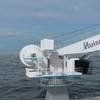Dorian LPG Post 3Q 2016 Profit
Dorian LPG Ltd. a leading owner and operator of modern very large gas carriers, today reported its financial results for the three months ended December 31, 2015.
Highlights – Third Quarter Fiscal 2016
* Revenues of $93.3 million
* Net Income of $54.7 million; Diluted Earnings Per Share of $0.97
* Adjusted EBITDA of $68.7 million*
* Took delivery of seven vessels under our ECO-design VLGC newbuilding program, the Clermont, the Cheyenne, the Cratis, the Commander, the Chaparral, the Copernicus, and the Challenger
* Repurchased 480,231 shares of our common stock for $5.8 million
* See reconciliation of net income to Adjusted EBITDA included in this press release
John Hadjipateras, Chairman, President and Chief Executive Officer, commented, "The third quarter was an extremely busy period for Dorian as we took the delivery of seven new Eco-design VLGCs. Our cash flow generated from operations has allowed us to repurchase an additional 480,231 shares of our common stock for $5.8 million over the quarter under the board's previously announced authorization to repurchase up to $100 million on or before December 31, 2016. Going forward, we anticipate higher profits and cash generated from operations as a result of our larger fleet, assuming continued favorable market conditions. We will continue to evaluate ways to best return that cash to our investors, underscoring the commitment of both the board and management to increasing shareholder value."
Third Quarter Fiscal 2016 Results Summary
Revenues were $93.3 million for the three months ended December 31, 2015, which represent net pool revenues-related party, voyage charters, time charters and other revenues earned by our VLGCs and our pressurized 5,000 cbm vessel, an increase of $60.7 million, or 186.3%, from $32.6 million for the three months ended December 31, 2014. The increase is primarily attributable to $68.1 million of revenues contributed by sixteen of our newbuilding VLGCs that were delivered subsequent to December 31, 2014.
This increase was partially offset by a decrease in revenues of $7.9 million due to a decrease in VLGC rates for vessels that were in our fleet during both three month periods. The Grendon's revenues increased $0.5 million to $0.7 million on 53 operating days for the three months ended December 31, 2015 from $0.2 million on 19 operating days for the three months ended December 31, 2014.
Voyage expenses were $4.3 million during the three months ended December 31, 2015, a decrease of $3.5 million, from $7.8 million for the three months ended December 31, 2014. Voyage expenses are all expenses unique to a particular voyage, including bunker fuel consumption, port expenses, canal fees, charter hire commissions, war risk insurance and security costs. Voyage expenses are typically paid by us under voyage charters and by the charterer under time charters, including pooling arrangements.
Accordingly, we generally only incur voyage expenses for voyage charters or during repositioning voyages between time charters for which no cargo is available or travelling to or from drydocking. The decrease for the three months ended December 31, 2015 when compared to the three months ended December 31, 2014 was mainly attributable to a decrease in the number of VLGCs operating on voyage charters and in fuel prices resulting in decreases in VLGC bunker costs of $2.6 million, port expenses of $0.8 million and other voyage expenses of $0.2 million.
The Grendon's voyage expenses increased $0.1 million to $0.4 million on 53 operating days for the three months ended December 31, 2015 from $0.3 million on 19 operating days for the three months ended December 31, 2014.
Vessel operating expenses were $14.3 million during the three months ended December 31, 2015, or $8,180 per vessel per calendar day, which is calculated by dividing vessel operating expenses by calendar days for the relevant time period for vessels that were in our fleet. This was an increase of $8.6 million from $5.7 million for the three months ended December 31, 2014.
The gross increase was primarily the result of an increase in the number of vessels operating in our fleet during the three months ended December 31, 2015 compared to the three months ended December 31, 2014. Vessel operating expenses per calendar day decreased $2,221 from $10,401 for the three months ended December 31, 2014 to $8,180 for the three months ended December 31, 2015.
The decrease in vessel operating expenses per day of $2,221 is primarily attributable to higher absorption of costs related to the training of additional crew over a greater number of calendar days on our expanded VLGC fleet and the reduced operating cost of our ECO-design VLGCs compared to the 82,000 cbm VLGCs in our fleet. The Grendon's vessel operating expenses decreased $0.1 million to $0.5 million for the three months ended December 31, 2015 from $0.6 million for the three months ended December 31, 2014 due mainly to a decrease in repairs and maintenance and stores and spares of $0.1 million.
Depreciation and amortization was $13.5 million for the three months ended December 31, 2015, an increase of $9.5 million from $4.0 million for the three months ended December 31, 2014 that mainly relates to depreciation expense for our additional operating vessels.
General and administrative expenses were $7.5 million for the three months ended December 31, 2015, an increase of $3.2 million from $4.3 million for the three months ended December 31, 2014, mainly due to an increase of $1.3 million for certain non-capitalizable costs incurred prior to vessel delivery, $0.6 million for salaries, wages and benefits, $0.5 million for stock-based compensation, and $0.8 million for other general and administrative expenses. For the three months ended December 31, 2015, general and administrative expenses were comprised of $2.5 million of salaries and benefits, $1.4 million for certain non-capitalizable costs incurred prior to vessel delivery, $1.3 million of stock-based compensation, $0.8 million for professional, legal, audit and accounting fees and $1.5 million of other general and administrative expenses.
Interest and finance costs amounted to $4.6 million for the three months ended December 31, 2015, an increase of $4.6 million from less than $0.1 million for three months ended December 31, 2014. The increase of $4.6 million during this period was mainly due to a $4.7 million increase in interest incurred on our long-term debt, amortization and other financing expenses from $1.0 million in the three months ended December 31, 2014 to $5.7 million in the three month period ended December 31, 2015.
These increases were partially offset by a $0.1 million increase in capitalized interest from $1.0 million in the three months ended December 31, 2014 to $1.1 million in the three months ended December 31, 2015. The average indebtedness during the three months ended December 31, 2015 was $711.8 million compared to $123.3 million during the three months ended December 31, 2014, reflecting debt drawdowns made under our 2015 Debt Facility. The outstanding balance of our long term debt as of December 31, 2015 was $814.1 million.
Gain/(loss) on derivatives, net, amounted to a net gain of approximately $5.4 million for the three months ended December 31, 2015, compared to a net loss of $1.3 million for the three months ended December 31, 2014. The net gain on derivatives for the three months ended December 31, 2015 was comprised of an unrealized gain of $7.4 million from the changes in the fair value of the interest rate swaps due mainly to changes in yield curves, partially offset by a realized loss of $2.0 million due mainly to an increase in notional debt amounts. For the three months ended December 31, 2014, the net loss on derivatives was primarily comprised of a realized loss of $1.3 million and an unrealized loss of less than $0.1 million from the changes in the fair value of the interest rate swaps.
During the quarter, we repaid $10.6 million of bank debt under our loan facilities and we finished the quarter with $22.0 million of unrestricted cash. As of December 31, 2015, we had $53.3 million of remaining payments due under our VLGC Newbuilding Program.
Market Outlook Update
Global liquefied petroleum gas ("LPG") export volumes for the calendar 2015 reached 80 million metric tons, an 11% increase over the previous year. U.S. LPG exports alone reached a record of nearly 21 million metric tons, which is a 50% increase over the previous year. The U.S. became the largest LPG exporter in the world, accounting for 25% of the global seaborne export volumes, which were shipped to Central and South America, Asia, and Europe and the Mediterranean at about 43%, 29% and 26%, respectively.
The strong LPG export volumes from the U.S. Gulf and in particular large cargo movements (on VLGC vessels) from West to East have increased ton-miles for the segment Dorian LPG has focused on and has supported shipping demand for VLGC vessels. Other LPG exporting regions have shown export growth in 2015 and have generally contributed to a generally stronger Baltic rate market resulting in strong utilization and freight rates seen by VLGC vessels.
Propane and Butane prices have followed crude oil prices downward, making LPG attractive not only to the retail domestic markets, but also to the petrochemical industries around the world. The continuing U.S. LPG export capacity growth is evident with the recent Enterprise expansion, the expected Marcus Hook Mariner East export terminal (commencement in February 2016), the Petrogas terminal (expected capacity increase of 0.35 million tons during 2016), and the Phillips 66 terminal at Freeport, Texas (4.4 million tons annual capacity expected to open in the fourth quarter of 2016). We therefore expect that U.S. LPG export volumes may reach higher levels in 2016, which would support additional ship supply and a reasonably robust freight rate market environment for the sector.
While these factors continue to support strong fundamental demand for LPG and LPG shipping, there can be no assurances that such trends will continue or that anticipated future freight rates, export capacity, or export volumes will materialize.
Seasonality
Liquefied gases are primarily used for industrial and domestic heating, as a chemical and refinery feedstock, as a transportation fuel and in agriculture. The liquefied gas carrier market is typically stronger in the spring and summer months in anticipation of increased consumption of propane and butane for heating during the winter months.
In addition, unpredictable weather patterns in these months tend to disrupt vessel scheduling and the supply of certain commodities. As a result, demand for our vessels may be stronger in our quarters ending June 30 and September 30 and relatively weaker during our quarters ending December 31 and March 31, although 12‑month time charter rates tend to smooth these short‑term fluctuations.
To the extent any of our time charters expires during the relatively weaker quarters ending December 31 and March 31, it may not be possible to re‑charter our vessels at similar rates. As a result, we may have to accept lower rates or experience off‑hire time for our vessels, which may adversely impact our business, financial condition and operating results.
Fleet
Each of our newbuildings is an ECO-design vessel incorporating advanced fuel efficiency and emission-reducing technologies. Upon completion of our VLGC Newbuilding Program with the final VLGC scheduled to be delivered to us in February 2016, 100% of our VLGC fleet will be operated as sister ships and the average age of our VLGC fleet will be approximately 1.6 years, while the average age of the current worldwide VLGC fleet is approximately 10.2 years.















